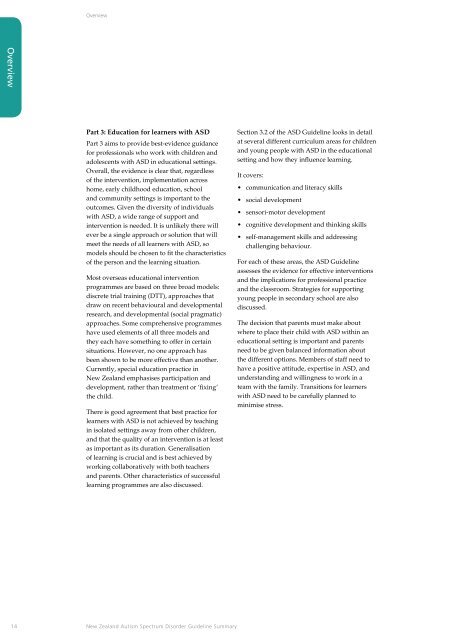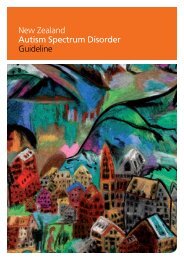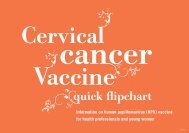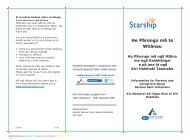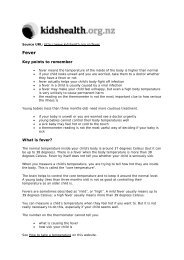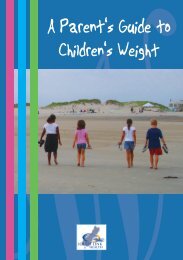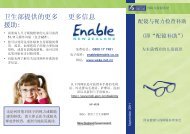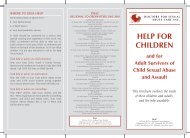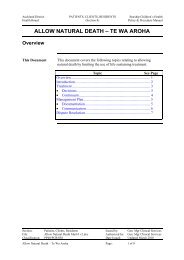New Zealand Autism Spectrum Disorder ... - Ministry of Health
New Zealand Autism Spectrum Disorder ... - Ministry of Health
New Zealand Autism Spectrum Disorder ... - Ministry of Health
Create successful ePaper yourself
Turn your PDF publications into a flip-book with our unique Google optimized e-Paper software.
Overview<br />
Overview<br />
Part 3: Education for learners with ASD<br />
Part 3 aims to provide best-evidence guidance<br />
for pr<strong>of</strong>essionals who work with children and<br />
adolescents with ASD in educational settings.<br />
Overall, the evidence is clear that, regardless<br />
<strong>of</strong> the intervention, implementation across<br />
home, early childhood education, school<br />
and community settings is important to the<br />
outcomes. Given the diversity <strong>of</strong> individuals<br />
with ASD, a wide range <strong>of</strong> support and<br />
intervention is needed. It is unlikely there will<br />
ever be a single approach or solution that will<br />
meet the needs <strong>of</strong> all learners with ASD, so<br />
models should be chosen to fit the characteristics<br />
<strong>of</strong> the person and the learning situation.<br />
Most overseas educational intervention<br />
programmes are based on three broad models:<br />
discrete trial training (DTT), approaches that<br />
draw on recent behavioural and developmental<br />
research, and developmental (social pragmatic)<br />
approaches. Some comprehensive programmes<br />
have used elements <strong>of</strong> all three models and<br />
they each have something to <strong>of</strong>fer in certain<br />
situations. However, no one approach has<br />
been shown to be more effective than another.<br />
Currently, special education practice in<br />
<strong>New</strong> <strong>Zealand</strong> emphasises participation and<br />
development, rather than treatment or ‘fixing’<br />
the child.<br />
There is good agreement that best practice for<br />
learners with ASD is not achieved by teaching<br />
in isolated settings away from other children,<br />
and that the quality <strong>of</strong> an intervention is at least<br />
as important as its duration. Generalisation<br />
<strong>of</strong> learning is crucial and is best achieved by<br />
working collaboratively with both teachers<br />
and parents. Other characteristics <strong>of</strong> successful<br />
learning programmes are also discussed.<br />
Section 3.2 <strong>of</strong> the ASD Guideline looks in detail<br />
at several different curriculum areas for children<br />
and young people with ASD in the educational<br />
setting and how they influence learning.<br />
It covers:<br />
• communication and literacy skills<br />
• social development<br />
• sensori-motor development<br />
• cognitive development and thinking skills<br />
• self-management skills and addressing<br />
challenging behaviour.<br />
For each <strong>of</strong> these areas, the ASD Guideline<br />
assesses the evidence for effective interventions<br />
and the implications for pr<strong>of</strong>essional practice<br />
and the classroom. Strategies for supporting<br />
young people in secondary school are also<br />
discussed.<br />
The decision that parents must make about<br />
where to place their child with ASD within an<br />
educational setting is important and parents<br />
need to be given balanced information about<br />
the different options. Members <strong>of</strong> staff need to<br />
have a positive attitude, expertise in ASD, and<br />
understanding and willingness to work in a<br />
team with the family. Transitions for learners<br />
with ASD need to be carefully planned to<br />
minimise stress.<br />
14<br />
<strong>New</strong> <strong>Zealand</strong> <strong>Autism</strong> <strong>Spectrum</strong> <strong>Disorder</strong> Guideline Summary


